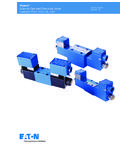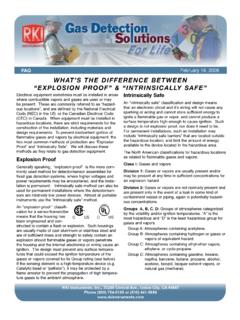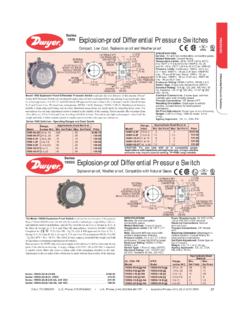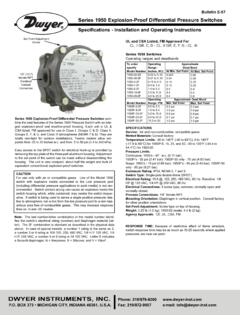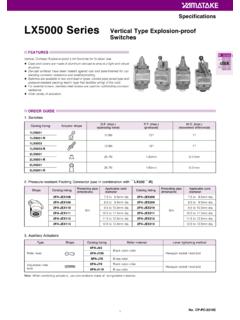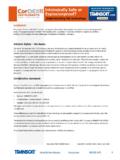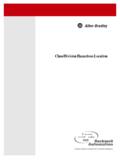Transcription of WHITE PAPER on Explosion Proof and Intrinsic …
1 WHITE PAPER on Explosion Proof and Intrinsic safety solutions Oct. 2013 2013, HCL Technologies. Reproduction Prohibited. This document is protected under Copyright by the Author, all rights reserved. Abstract .. 3 Abbreviations .. 4 Introduction to Standards .. 5 Protection Layers .. 7 Simple Devices .. 7 Mechanical Design Considerations .. 8 Intrinsic Safe Design Considerations .. 14 Example Motors .. 16 18 TABLE OF CONTENTS 2013 HCL Technologies, Ltd. Reproduction prohibited. This document is protected under copyright by the author. All rights reserved. 3 Abstract Oil refineries, petrochemical processing plants and even coal mines to a certain extent operate in the presence of combustible gases and vapors.
2 So, it s very important for equipment, more specifically electrical and electronic equipment that operate in that atmosphere, not to cause a spark which can ignite the gases, leading to an Explosion . Explosion Proof / Intrinsic safety are two technologies which guarantee that under no circumstances will equipment emit energy to cause an Explosion . The objective of this document is to describe how to do the mechanical and electronic design for electrical/electronic equipment deployed in a hazardous environment. This document does not cover barriers placed in safe areas, and focuses only on devices placed in hazardous areas. Explosion Proof / Intrinsic safety are two technologies which guarantee that under no circumstances will equipment emit energy to cause an Explosion 2013 HCL Technologies, Ltd.
3 Reproduction prohibited. This document is protected under copyright by the author. All rights reserved. 4 Abbreviations Sl. No. Acronym Full Form 1 ATEX The ATEX directive, or the standard describing what equipment and work environment is allowed in an environment with an explosive atmosphere. ATEX is an acronym for ATmosph res EXplosives 2 Ex. Acronym used to indicate that equipment is Explosion Proof 3 IECEx IEC Standards for devices to be used in a hazardous region. Similar to ATEX 4 NEC National Electric Code standards followed in North America 5 UL, FM Underwriters Laboratories, Factory Mutual agencies that conduct compliance tests and issue certifications 2013 HCL Technologies, Ltd.
4 Reproduction prohibited. This document is protected under copyright by the author. All rights reserved. 5 Introduction to Standards For an electrical/electronic device to be used in a hazardous environment, it needs to be certified to ensure it does not under any circumstances emit energy that could cause an Explosion . There is no one single standard universally followed for Explosion Proof certification. In Europe, compliance with ATEX Directive 94/9/EC is mandatory when installing and commissioning electronic or mechanical devices in hazardous locations In the United States, compliance is based on the National Electrical Code (NEC); in Canada it is the Canadian Electric Code (CEC) IECEx, namely IEC 60079, is an Explosion - Proof standard from the IEC, the international body on electrical standards, that is followed by the rest of the world In fact, the list is more than shown above - CSA, ANZex, AUSEx, UL and FM are the other Explosion Proof standards, each having its own set of compliance requirements, though subscribing to a similar broad category of rules.
5 To which standard to comply? Unless there are rigid country/region specific mandates to be followed, IECEx certification should be considered. Products complying to IECEx can also comply to ATEX, while the reverse may not necessarily be true. The table below gives the area classification as per ATEX/IEC and NEC. Based on the location of the equipment, the equipment needs to comply with the standards requirements for that area. ATEX, NEC , IECEx are some of the most commonly used standards. Complying to Zone 0 is the most challenging. 2013 HCL Technologies, Ltd. Reproduction prohibited. This document is protected under copyright by the author.
6 All rights reserved. 6 ATEX & IEC Zone 0 Zone 1 Zone2 Explosive gases are present all the time, or for long periods of time Explosive gases are likely to present in normal conditions (occasionally) Explosive gases are not likely to present in normal conditions or are present for short durations NEC Division 1 Division 2 Explosive gases are likely to be present during normal operation and exist frequently during maintenance or repair Explosive gases are not likely to be present in normal conditions Note: IECEx has an additional area called a Safe Area, where explosive gases are not present at any time NEC has another classification based on explosive material called Class.
7 Class I includes flammable gas, vapours, and liquids, Class II is combustible dusts and Class III is ignitable fibres and flyings. Divisions 1 & 2 are considered for each class. ATEX has two types of certifications - Ex ia and Ex ib. Ex ia may be used in Zones 0/1/2, Ex ib may only be used in Zones 1/2 Products are also certified based on gases that are present in the atmosphere, known as gas groups as shown in the table below with Group IIC being the most severe. Devices certified for IIC can be used within any other gas atmosphere. Group Gases I Methane gas in mining IIA Industrial methane, petrol IIB Ethylene, coke oven gas and other industrial gases IIC Acetylene, Hydrogen Explosion Proof /isolation/ Intrinsic safety are three types of protection mechanisms 2013 HCL Technologies, Ltd.
8 Reproduction prohibited. This document is protected under copyright by the author. All rights reserved. 7 Protection Layers There are three types of protection mechanisms to make a product usable in a hazardous atmosphere Explosion Proof - Enclose the equipment in an Explosion - Proof enclosure so any ignition or fire from inside the equipment is contained within the equipment and does not spread outside Isolating the explosive gases from a device. That could be by pressurization of the device to prevent outside atmosphere from entering or by immersing the electrical components in an inert oil so no sparks are produced. Intrinsic safety The electrical/electronic design includes protection mechanisms limiting the energy available for ignition under any circumstances.
9 This is applicable for electrical/electronic equipment operating at low voltages (example 24 VDC), and not for motors that operate at high voltages. For Zone 0, Intrinsic safety compliance is the only accepted technique, even if the device is Explosion - Proof for devices operating at low voltages It is common to find devices, specifically those operating at low voltages, to be Explosion - Proof and Intrinsic safe certified. Simple Devices A simple device or apparatus does not generate or store more or 100mA or 20mJ or 25mW. Such devices are incapable of causing ignition, and need no compliance to Explosion Proof or Intrinsic safety . A flame- Proof enclosure is the most common technique used in Explosion proofing 2013 HCL Technologies, Ltd.
10 Reproduction prohibited. This document is protected under copyright by the author. All rights reserved. 8 Mechanical Design considerations Explosion proofing is very much a mechanical engineering design. Common techniques for implementing Explosion proofing are explained below. Flame Proof Enclosure This method is based on the concept of Explosion containment. The ignition source is permitted to come in contact with the hazardous air/gas mixture. In case of an Explosion , the Explosion must remain confined within the enclosure. The enclosure is built to resist the excess pressure created by an internal Explosion , thus impeding propagation to the surrounding atmosphere.



